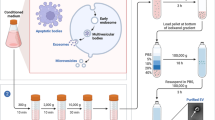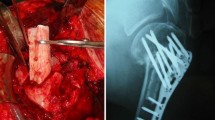Abstract
One of the most important factors concerning the successful clinical outcome after transplantation of osteochondral allografts is the viability of the cartilage.The viability of cryopreserved cartilage is quite poor, 20–30% cell survival has been published. The purpose of this study was to develop a new storage method which improves the chondrocyte viability. The talus of cadaveric donors was used as a model tissue to compare human osteochondral allograft cartilage viability following cryopreservation with that remaining after prolonged refrigerated storage. Full-thickness cartilage punch biopsies had been cryopreserved, and tali were divided into two matched groups and stored in TCM for 60 days at +4 °C, either with or without regular medium replacement. The cartilage of each graft was biopsied and assayed for viability on every third day by the MTT reduction assay. During 4 °C storage, a recurring pattern of large fluctuations in apparent cartilage viability was observed in every stored graft, with or without medium replacement. These fluctuations did not appear in control specimens of either fresh or cryopreserved human skin that were assayed in parallel with the cartilage biopsies, so the viability fluctuation seems an intrinsic property of the cartilage in these conditions. Cartilage stored for 60 days at +4 °C showed significantly higher viability (35.2 ± 3.3 %) than fresh cartilage that had been cryopreserved (21.6 ± 1.8 %). This was true even when cryopreserved and thawed cartilage was subjected to a 3 day post thaw incubation under presumably favorable conditions (17.7 ± 1.6 %). These viability assay results, (reflective of intracellular metabolic activity), were corroborated by the fluorescent dye mixture SYTO-16 and propidium iodide. The data indicate that long-term stored refrigerated cartilage appears to retain a viability higher than that of cryopreserved cartilage for up to and perhaps beyond 60 days of storage. There was no viability index difference between the medium replaced and non-replaced groups. Although an exceptional result, in one individual case, more than 65% viable cells could be detected in the talar cartilage after 60 days storage at +4 °C.
Similar content being viewed by others
References
American Red Cross 1994. Standards of the American Red Cross Tissue Services. American Red Cross, Washington, DC, USA, pp 73.
Amiel D., Harwood F.L., Hoover J.A. and Meyers M. 1989. A histological and biochemical assessment of the cartilage matrix obtained from in vitro storage of osteochondral allografts. Connective Tissue Research 23: 89–99.
Benya P.D. and Nimni M.E. 1979. The stability of the collagen phenotype during stimulated collagen, glycosaminoglycan, and DNA synthesis by articular cartilage organ cultures. Archives of Biochemistry and Biophysics 192: 327–335.
Brighton C.T., Shadle C.A., Jimenez S.A., Irwin J.T., Lane J.M. and Lipton M. 1979. Articular cartilage preservation and storage I. Application of tissue culture techniques to the storage of viable articular cartilage. Arthritis and Rheumatism 22: 1093–1101.
Csonge L., Bravo D., Newman-Gage H., Rigley T., Conrad E.U., Bakay A. et al. 2002. Banking of Osteochondral Allografts. Part I. Viability Assays Adapted for Osteochondral and Cartilage Studies. Cell and Tissue Banking.
Curran R.C. and Gibson T. 1956. The uptake of labelled sulfate by human cartilage cells and its use as a test for viability. Proc. R. Soc. Br. 144: 572–576.
Czitrom A., Keating S. and Gross A.E. 1990. The viability of articular cartilage in fresh osteochondral allografts after clinical transplantation. J. Bone Surg. 72A: 574–581.
Hagerty R.F., Braid H.L., Bonner W.M., Hennigar G.R. and Lee W.H. 1967. Viable and non viable human cartilage homografts. Surg. Gynec. & Obst. 125: 485–492.
Hagerty R.F., Calhoon T.B., Lee W.H. and Cuttino J.T. 1960. Human cartilage stored in air. Surg. Gynecol. Obstet. 110: 443–436.
Hagerty R.F., Calhoon T.B., Lee W.H. and Cuttino J.T. 1967. Human Cartilage stored in plasma. Surg. Gynecol. Obstet. 125: 277–281.
Malinin T.I., Mnaymneh W., Lo H.K. and Hinkle D.K. 1994. Cryopreservationof articular cartilage. Clin. Orthop. 303: 18–32.
Mossmann T. 1983. Rapid colorimetric assay for cellular growth and cytotoxic assays. J. Immunol. Methods 65: 55–63.
Oates K.M., Chen A.C., Young E.P., Kwan M.K., Amiel D. and Convery F.R. 1995. Effect of tissue culture storgae on the in vivosurvival of canine osteochondral allografts. J. Orthop. Res. 13: 562–569.
Pap K. and Krompecher S. 1961. Arthroplasty of the Knee. J. Bone Joint Surg. 43A: 523–537.
Rodrigo J., Thompson E. and Travis C. 1980. 4 8C preservation of avascular osteocartilaginous shell allografts in rats. Trans. Orthop. Res. Soc. 5: 72–76.
Sammarco V.J., Gorab R., Miller R. and Brooks P.J. 1997. Human articular cartilage storage in cell culture medium: guidelines for storage of fresh osteochondral allografts. Orthopedics 20: 497–500.
Schachar N.S., Cucheran D.J., McGann L.E., Novak K.A. and Frank C.B. 1994. Metabolic activity of bovine articular cartilage during refrigerated storage. J. Orthop. Res. 12: 15–20.
Schachar N.S. and McGann L.E. 1986. Investigations of low temperature storage of articular cartilage for transplantation. Clin. Orthop. 208: 146–150.
Tomford W.W., Duff G.P. and Mankin H.J. 1985. Experimental freeze-preservation of chondrocytes. Clin. Orthop. 197: 11–14.
Tomford W.W., Fredericks M.S. and Mankin H.J. 1982. Cryop-reservation of intact articular cartilage. Trans. Orthop. Res. Soc. 7: 176–180.
Tomford W.W., Springfield D.S. and Mankin H.J. 1992. Fresh and frozen articular cartilage allografts. Orthopaedics 15: 1183–1188.
Wayne J.S., Amiel D., Kwan M.K., Woo S.L.Y., Fierer A. and Meyers M. 1990. Long-term storage effects on canine osteochondral allografts. Acta. Orthop. Scand. 61: 539–545.
Author information
Authors and Affiliations
Rights and permissions
About this article
Cite this article
Csönge, L., Bravo, D., Newman-Gage, H. et al. Banking of osteochondral allografts, Part II. Preservation of Chondrocyte Viability During Long-Term Storage. Cell Tissue Banking 3, 161–168 (2002). https://doi.org/10.1023/A:1023687419152
Issue Date:
DOI: https://doi.org/10.1023/A:1023687419152




